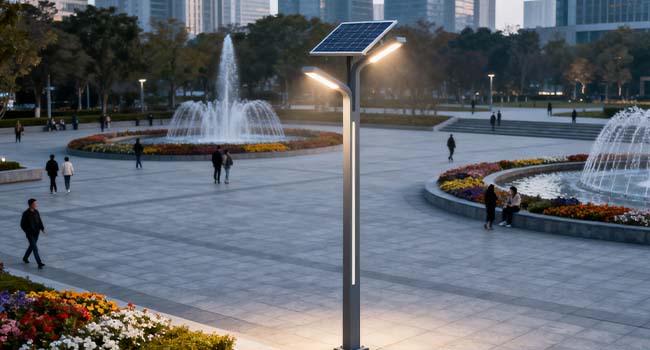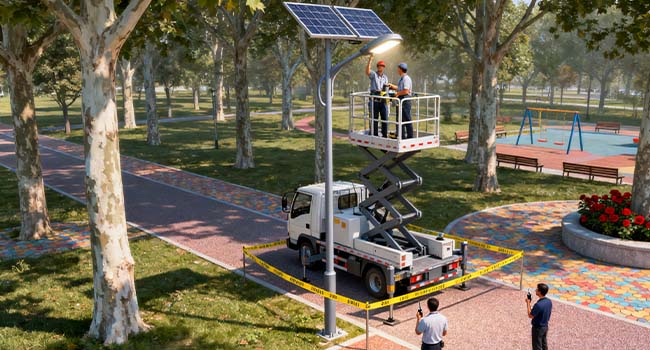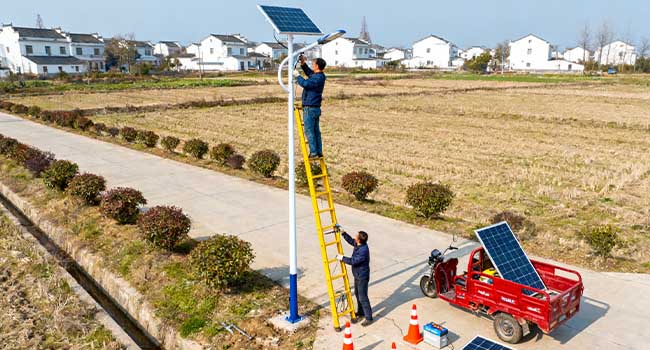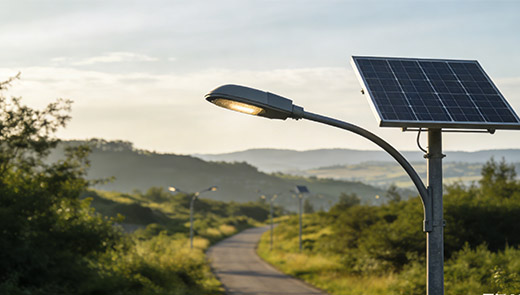Why Do My Solar Lights Turn On During the Day?
The core design principle of solar lights is “charging by day, illuminating by night.” Yet many users encounter this perplexing issue: on bright sunny days, their solar lights activate, only to run low on power and dim at night. This “day-on, night-off” anomaly isn't always a device malfunction—it's more often caused by sensor issues, battery problems, or installation environment details.

5 Reasons Why Solar Lights Turn On During the Day
Defective Light Sensors
The light sensor acts as the “eyes” of the solar light, detecting ambient light intensity. When light falls below the threshold (e.g., at night), it triggers the light to turn on; when light exceeds the threshold (e.g., during the day), it triggers the light to turn off and enter charging mode. If the sensor suffers physical damage—such as surface cracks, dents, or internal component damage from rain or high temperatures—it loses its ability to accurately detect light levels.
Even if the sensor appears intact, if its surface is covered by dust, bird droppings, or leaf debris—effectively “blocking its eyes”—it may mistakenly identify daytime as nighttime. Additionally, some low-cost solar lights feature sensors with substandard sensitivity, exhibiting design flaws from the factory that cause them to activate under normal light conditions. These issues can all lead to solar lights turning on abnormally during the day.
Insufficient Sunlight
Solar lights require ample direct sunlight to function properly. This is essential not only for battery charging but also for the sensor to accurately determine “daytime.” Improper installation—where the light is obstructed by buildings, trees, or balconies—can result in less than 4 hours of direct sunlight daily, preventing the sensor from receiving sufficient light signals. Additionally, during prolonged periods of overcast, rainy, or hazy weather, ambient light intensity may fall below the sensor's preset “night threshold” even during daylight hours. These factors can cause the solar light to turn on during the day while also reducing nighttime brightness due to insufficient charging.
Dirty Solar Panels
Solar panels serve two core functions: absorbing sunlight to convert it into electrical energy stored in the battery, and assisting the sensor in detecting ambient light levels. When panels become covered with dust, leaves, or grease, two problems arise simultaneously: First, the debris blocks sunlight, preventing the battery from fully charging during the day and affecting nighttime illumination.
Second, surface grime reduces reflected light intensity, causing the sensor to mistakenly interpret “darkness” and trigger the lighting mode. Data indicates that even a thin layer of dust can reduce the panel's photovoltaic conversion efficiency by 5%-15%, while severely disrupting light sensing. This is a major cause of solar lights illuminating during daylight hours.
Faulty Wires or Damaged Batteries
The battery serves as the solar light's “energy reservoir,” while wiring acts as the “energy transmission channel.” Issues with either can not only cause daytime illumination but also shorten the device's lifespan. From the battery perspective, standard lead-acid batteries in solar lights last approximately 1-2 years, while lithium batteries typically last 3-5 years. After exceeding their lifespan, batteries may exhibit issues like “failure to charge” or “sudden drop in storage capacity.” Unable to store sufficient energy during the day, they rely solely on minimal real-time power to maintain illumination, leading to complete power depletion by nightfall.

From a wiring perspective, outdoor use exposes cables to risks like rodent chewing or water logging, which can cause connector oxidation and interrupt current flow. This prevents sensors and batteries from coordinating properly, triggering false activations. Additionally, poorly soldered internal connections may loosen over time, causing circuit disruptions that similarly result in daytime illumination.
Moisture/Water Penetration
Although most solar lights are labeled with an “IP65 waterproof rating” (resistant to water jets and dust), prolonged outdoor use can lead to issues like seal aging and housing cracks, allowing moisture to seep into the device. Moisture primarily affects solar lights in three ways: First, sensor short-circuiting—water entering the sensor can cause circuit short-circuits, preventing the sensor from detecting light properly and likely triggering the lighting mode; Second, battery moisture exposure. Moisture contact can cause battery leakage, swelling, and significant capacity loss, while potentially corroding electrical connectors. Third, circuit board damage. Moisture-exposed main control boards may experience “command disruption,” such as forcing lights to remain constantly on. These water- or moisture-induced faults all cause solar lights to stay illuminated during daylight hours.
5 Easy Ways to Fix Solar Lights That Come On During the Day
Check the Light Sensor
First, turn off the solar light's power switch (if present). Carefully wipe the sensor surface with a dry cloth to remove dust, leaves, or other debris. Apply gentle pressure to avoid damaging the sensor. Next, inspect the sensor for cracks, dents, or other physical damage. If the surface appears intact, move the light to direct sunlight and wait 30 minutes. Observe whether the light turns off. If it does, the issue was caused by dirt. If the light remains on after cleaning, an internal sensor malfunction is likely. Contact the solar light manufacturer to purchase a replacement sensor of the same model. Insert the new sensor, reassemble the housing, and the light should function normally after replacement.

Ensure There’s No Water Penetration
If recent rainfall occurred, first inspect the lamp housing for cracks and check the seal ring for deformation, blackening, or other signs of aging—common entry points for water ingress. Then, use a screwdriver to disassemble the housing and inspect the interior for accumulated water or droplets. If present, thoroughly dry the sensor, circuit board, and battery surfaces with a dry cloth, paying close attention to corners and crevices.
Adjust the Installation Position to Ensure Adequate Sunlight Exposure
First, note the current installation location of the solar light. Observe whether any obstructions like buildings, trees, or balconies block sunlight between 9:00 AM and 3:00 PM daily (peak sunlight hours). If so, mark the extent of the obstruction. Then relocate the light to an unobstructed area, ensuring the solar panel receives direct sunlight for at least 6 hours daily. Install it at a height where the panel remains unobstructed.
Replace Aged/Damaged Batteries
Use a screwdriver to open the lamp's battery compartment. Carefully remove the old batteries and inspect them for damage such as leakage or swelling. Record the battery model (common types include 1.2V rechargeable batteries and 3.7V lithium batteries) and capacity to avoid purchasing incompatible replacements. Opt for branded batteries when purchasing; low-quality batteries not only have poor storage capacity but may also damage internal components due to leakage. When installing new batteries, ensure correct polarity alignment. After installation, close the compartment and place the light in direct sunlight for 4-6 hours to charge. Observe if it illuminates during daylight hours. If daytime illumination ceases and nighttime lighting functions normally, the battery replacement was successful.
Reset the Light to Address “Software Glitches”
If the light continues to illuminate during daylight hours after attempting the above 5 steps, the device may have experienced a “program malfunction.” This can be resolved by resetting it: First, turn off the power switch and remove the batteries. Place both the light unit and batteries in a completely dark environment (such as a closet) and leave them undisturbed for 72 hours. This step will fully discharge any residual power within the device, resetting the sensor's day-night detection program.
After 72 hours, reinstall the batteries, turn on the power switch, and move the light to direct sunlight to allow the device to re-detect the day-night cycle. Typically, the device will resume normal operation after reset. If the issue persists after reset, it is likely a manufacturing defect (e.g., circuit board flaw). Contact the solar light manufacturer's after-sales service. If within the warranty period (usually 1-2 years), the manufacturer will typically provide free replacement or repair.
Most daytime illumination issues in solar lights aren't complex faults. Simple troubleshooting like cleaning the sensor, checking for water ingress, adjusting the installation position, or replacing the battery can resolve the majority of problems. By following the methods outlined in this article, you can quickly restore the light to its normal “charge by day, illuminate by night” function. This approach requires minimal effort, enhances the solar light's durability, and reduces future complications.




